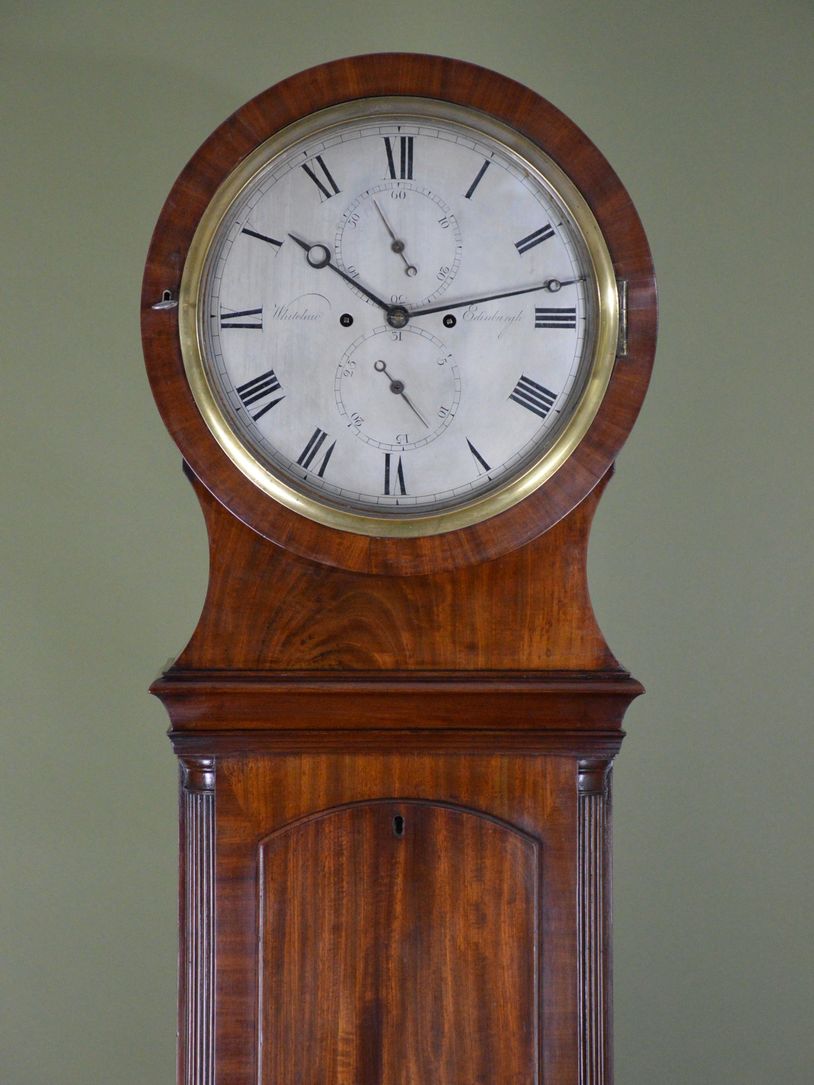Scottish longcase clock

Longcase clock by Whitelaw - edinburgh
£SOLD
A finely made flame mahogany drum head Scottish Longcase clock signed "Whitelaw - Edinburgh" with 8 day anchor mechanism striking the hours upon a single bell. The silvered brass dial is engraved with roman numerals and sub dials showing seconds and calendar. The mechanism is of extremely robust design and incorporates a wooden rod compensation pendulum with large lead filled bob.
The case is comprised of rich mahogany veneer with a top locking trunk door
" At a meeting of the Society of Arts for Scotland held on June 1829, Prize awarded to mr David Whitelaw, watchmaker, Princes Street, Edinburgh, of the Society's Silver Medal, value £5, 55., for his description and drawings of a clock pendulum without the crutch, and in which the pendulum receives the impulse directly from the swing wheel. This communi- cation, although only read in the beginning of the current year, was notified to the Society in 1828 and is so intimately connected with the one by Mr Alexander Doig, Musselburgh, that in justice to neither of these individuals can they be separated, and the committee recommend to the Society the donation of a prize to each without entering into any inquiry as to the priority of invention."
Paper read at a meeting of the Society of Arts for Scotland 5th June 1830. — ''Description of a pendulum chronometer in which the arbors of the wheels move on friction rollers, and the pinion leaves are made so as to revolve by the impulse of the wheel teeth, which are of a peculiar form made by mr David Whitelaw, watch and clock maker, No. 16 Princes Street, Edinburgh, for the late Andrew Waddell, Esq., Hermitage Hill, Leith."
Paper read by John Robinson, Esq., Secretary of the Royal Society, Edinburgh, 7th February 1831, regarding a time-keeper in the hall of the Royal Society of Edinburgh.1 — " The principal circumstances in which this time-keeper differs from the usual construction are these :—
" 1st. In having an escapement which requires no oil.
"2nd. In having the pendulum and ball formed of a material not hitherto used for this purpose.
"3rd. In having the mechanism entirely secured against the effects of dust, and in a great degree against those of hygrometric changes in the atmosphere.
" The escapement is the invention of Mr Whitelaw, a very ingenious artist in this city, who has been employed to make the clock. The next peculiarity in this clock is the material of which the pendulum rod and ball have been made. Marble has been adopted for this purpose in consequence of a suggestion made to me by Dr Brewster. Case was made air-tight, excepting in one place where a short tube is fixed in an opening from which projects externally about two inches, on which a half-distended air-bag is made fast"
The Whitelaw family are referenced in the book by John Smith ""Old Scottish clockmakers 1453 - 1850" :
---- references: "Old Scottish clockmakers 1453 - 1850" by John Smith page 391 ----
gallery
Cookie Policy
This website uses cookies. By continuing to use this site, you accept our use of cookies.